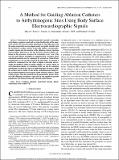A method for guiding ablation catheters to arrhythmogenic sites using body surface electrocardiographic signals
Author(s)
Barley, Maya E.; Armoundas, Antonis A.; Cohen, Richard J.
DownloadBarley_Method-for-Guiding.pdf (314.8Kb)
PUBLISHER_POLICY
Publisher Policy
Article is made available in accordance with the publisher's policy and may be subject to US copyright law. Please refer to the publisher's site for terms of use.
Terms of use
Metadata
Show full item recordAbstract
Treatment of hemodynamically unstable ventricular arrhythmias requires rapid and accurate localization of the reentrant circuit. We have previously described an algorithm that uses the single-equivalent moving dipole model to rapidly identify both the location of cardiac sources from body surface electrocardiographic signals and the location of the ablation catheter tip from current pulses delivered at the tip. However, during catheter ablation, in the presence of sources of systematic error, even if the exit site and catheter tip dipole are superposed in real space, their calculated positions may be separated by as much as 5 mm if their orientations are not exactly matched. In this study, we present a method to compensate for the effect of dipole orientation and examine the method's ability to guide a dipole at a catheter tip to an arrhythmogenic dipole corresponding to the exit site. In computer simulations, we show that the new method enables the user to guide the catheter tip to within 1.5 mm of the arrhythmogenic dipole using a realistic number of movements of the ablation catheter. These results suggest that this method has the potential to greatly facilitate RF ablation procedures, especially in the significant patient population with hemodynamically unstable arrhythmias.
Date issued
2009-04Department
Harvard University--MIT Division of Health Sciences and TechnologyJournal
IEEE Transactions on Biomedical Engineering
Publisher
Institute of Electrical and Electronics Engineers
Citation
Barley, M.E., A.A. Armoundas, and R.J. Cohen. “A Method for Guiding Ablation Catheters to Arrhythmogenic Sites Using Body Surface Electrocardiographic Signals.” Biomedical Engineering, IEEE Transactions on 56.3 (2009): 810-819. © 2009 Institute of Electrical and Electronics Engineers
Version: Final published version
ISSN
0018-9294
Keywords
ventricular tachycardia (VT), equivalent moving dipole, catheter ablation